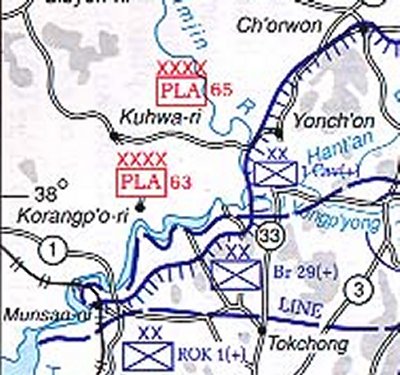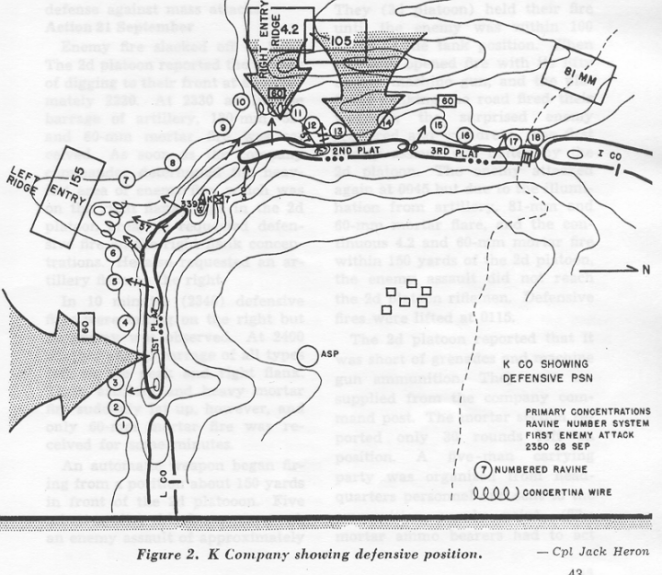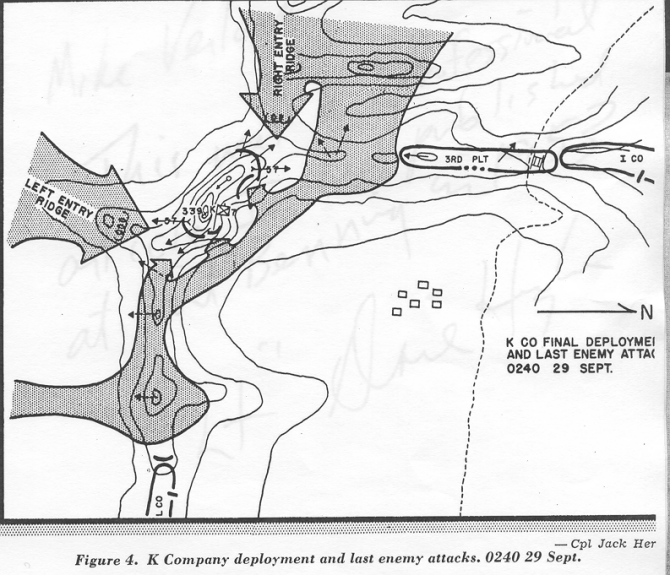To get an idea what we were up against in the Yonchon Sector from August to November 1951, this map shows that the Chinese had two ARMIES (xxxx), the 63d and 65th opposite the 1st Cavalry Division (xx) and the British 29th Brigade (xx) and the ROK 1st Division (xx)

Below are verbatim extracts of a long 8 page Letter about my Battle for Hill 339 the 21st to 28th September 1951. I hunt and pecked out a letter on the only typewriter on board the Oturu Maro troop ship enroute to Seattle from Japan in February 1952. It was addressed to Capt John Flynn. Flynn had been my first K Company commander in Korea in 1950. He was promoted to Major and was the Operations Officer for the 7th Cavalry Regiment under Col Gilmer when he was wounded by mortar fire while standing next to Gilmer, and then was stationed at Fort Benning as he recovered from his wounds. I had succeeded him as K Company Commander in August of 51.
Since I was sent later on the advanced party to Japan with the S-3 Headquarters of the 7th Cav in December and January 1952 while it was being exchanged with a regiment from the Oklahoma National Guard 45th Division, I had both the time and opportunity to study the classified and unclassified written Cav reports on the operations of the whole 7th Cav, and my 3d Battalion from September through November in the Yonchon sector. Including the battles for Hills 487, 339, and 347, and put them together with my very fresh memory of all three battles. So my extracts below are an accurate description of those operations and their outcomes. Later while at Fort Benning, I prepared an article about the Battle for Hill 339, and the three illustrations below are from that article. They give a visual picture of the text from the letter about the unfolding battle the night of 27-28 September
Before going up on Hill 339 I had learned that Col Gilmer, 7th Cav Regimental Commander had directly ordered Lt Col Haldane the 3d Battalion Commander to put "Lt Dave Hughes and his Company K" on Hill 339 to defend it. Gilmer expected me, a fellow West Pointer who had gotten a reputation for fighting effectively in combat actions over the past several months, to walk on water. This turned out to be one of the toughest combat missions I ever was given.
Start of verbatim extracts from letter to Flynn about Hill 339.
“ Company K got the delightful mission of holding 339, and 1,000 more yards of perimeter.
We moved out and after plastering the hill from an OP [observation post] on 321, 1,500 yards away, we went up, but the Chinese set off a red flare and pulled off. I topped the peak and about five minutes afterward learned what the score was going to be for the next two weeks. They suddenly began shelling us and mortaring until I thought the roof was going to come off the hill.
They kept working the front slope over with a battery of 75mms and self-propelled artillery and they shook us to pieces with more 120mm mortars than I thought we had in 4.2-inch. The rain of 82mm and 60mm was just incidental. The fewest incoming rounds we ever reported for 24 hours was 350, and we estimated 1,200 on the second day.
It took me until the second day to see why they had targeted us while hardly touching the rest of the perimeter. Once on the peak OP, I could see more of their positions and gun positions and access routes than they could afford to have me see, or order my Artillery and Mortar Field Observers to command long range fire to come down on them.
So it went. We dug in amidst dead enemy troops from earlier battles and tried to organize the hill. They watched us like hawks, though, and could see our rear slope from the flanks. We could not top the ridge or put a single man in position on the forward slope during daylight; they would just open up with the SP [self-propelled] guns and dig him right out of the hole. From bombardment alone, with very little movement on the hill, we took 33 casualties in a week from direct hits on holes with mortars and the midnight dose of 120's.
The first night, we had a scrap. They came across a little saddle from which they had hit Company C, and they came down the road on the extreme right flank. On the road they ran into a tank, and it scattered them while the mortar fire kept them dispersed. But on the peak they plastered us with everything they could, and came in right under their own mortar fire to hit the right shoulder of the hill and smack into Sergeant Malloy's machine gun. He waited until they were ten yards away and then cut loose. They did not definitely locate him in the confusion and noise, and he stopped them cold. They crawled around and poured machinegun fire on us for a few more hours and then pulled off their dead and withdrew. In the morning there were five dead enemy within those ten yards of Malloy, and one had his hand draped over the parapet. We took no casualties from the small arms.
This cat and mouse game went on for seven days while we took the brunt of all the fire in the battalion.
I made out a little card on the company positions and numbered the draws and worked the 60mm gun crews until they could get a round off on any concentration in 30 seconds. We were all up on the peak. It was only about 1,000 yards across the high ground, and nobody was more than ten yards from the crest, including the mortars. That paid off later too. Black Lieutenant Walker commanded the Weapons Platoon.
We sent out daily patrols that only got 600 yards before getting hit. On the 25th, I had to send out a platoon toward positions I knew were there. I didn't like it at all because the enemy had been get cagier and cagier and had been holding their fire. But out went Lt. Radcliffe and his 1st Platoon. The Chinese let them get 200 yards from the peak before opening up with cross-firing weapons. Radcliffe was killed instantly. The platoon sergeant, a corporal, didn't hesitate. He ordered marching fire , and the platoon took half the peak so the rest could get out. There were three dead. Sergeant Brown was cut down by a grenade near Radcliffe. He rolled over and took Radcliffe's .45 pistol and the maps and took them all back as he himself was carried out. A machine gunner who could not find a vantage point to set up his machinegun went up with it cradled in his arm with one belt of ammunition. He had to be evacuated for the burns on his arm. “
“Every night, enemy patrols would crawl up and feel us out. They plotted our weapons and counted our men. Every night I would have to get up and calm down a squad that thought the whole Chinese Army was out there. But this had one good effect. The men dug in tight. They kept their weapons spotless. They slept in the daytime and watched at night. The 60mm mortar crew got faster and faster under black platoon leader Lieutenant Walker, who had been school-trained in weapons control. I collected heavy machineguns and on the 28th had five heavies and seven lights across the front. But because of the fire and dwindling number of men, we had been able to put out only a few rolls of concertina wire on the two easy approaches. The engineers all but refused to work laying mines in front of us.
The night of the 28th came. The day had been quiet and it seemed as good a time as any for the big show. “
At 2330 a bombardment came in. It was deadly accurate and concentrated on the positions controlling the two approaches. It continued until 2400 and then, for a few minutes, stepped up to a frenzied firing of all kinds of shells.
Then I heard the rip of a burp gun on the left. At the same time, just as I popped out of my bunker, a purple flare went off on both flanks of the peak. I yelled off a series of concentrations to the FO's (forward observers), and the first sergeant roused the 60's on the phone. But before I had even given a command to the 60's, two plop plops came out, and in a second a flare was burning over each flank. They had fired in about 20 seconds from the enemy flares.

“By this time, all the defensive fires were going full blast, but I was waiting for the Sunday punch. It came in about 20 minutes later at 0110. The Chinese only had a strip of our territory about 150 yards long on the right and 200 yards on the left, but they sure filled it up. They moved a mortar onto the ridge of each flank and began peppering the CP (my command post). They got a couple of machineguns up there and fired overhead for their next attack. And they never stopped pounding the top of the hill with those 120s. Then they jumped off again. The Chinese companies that had penetrated sent people around behind us,, and they raked the back slope with small arms and cut off our communciations with battalion.”

I did not know this at the time, but two things had happened. One was that they had attacked neatly, the first time, just to the left of the two machineguns on the right flank and thus never touched any part of the 3d Platoon. Only two rifle platoons, with perhaps 60 men, were involved all night long! The second thing was that at the beginning of the attack, the battalion S-2 (intelligence) section had been monitoring the SCR 300 (captured US radio) stations, and their Chinese interpreter picked up the command channel of the battalion that was attacking my company. So all night long battalion headquarters had a running account of the battle and knew how we stood, from the talk on the company radios the Chinese used and their command radio. But, we on 339 did not know that, for we could barely communicate to battalion heaquarters.
When the big attack came at 0110, the two companies on the ridgeline on both flanks started the attack toward the peak. Just when they were exterting maximum pressue on the heavy machineguns at the shoulder of the peak on each flank, two more companies came at us on those two saddle approaches we had wired in. I was waiting for that, and on the left, as they started across the wire, we opened up with the 57mm (recoiless rifle) at 20 yards on the wire, and I called in the 155s at a range of 150 yards from us and the two fires caught the company on the move. “

On the right they attacked across that little saddle, and we were waiting there too. At the first sign of the attack I called in the 4.2 mortar fire to 125 yards, and it played havoc with the supporting troops. I started the 60mm mortars firing at top speed (by this time we were getting artillery flares) and then, as the first grenade throwing wave hit our positions, we turned on our two flame throwers. The first wave just expired [fried] where it was. In a short time we were out of flame thrower juice, but it had scared them and the next waves walked across instead of running. I kept dropping the 60mm fire closer and closer until we went to 83 degrees - firing nearly vertically - when firing on a gun to target range of 65 yards and we were dropping shells only 15 yards in front of the machinegunner. PFC Mostad went back and forth between the ridge and the guns and actually gave the firing commands directly down to the 60mm mortar gunners by voice. Things were VERY dicey. It finally broke them, but only after they had got the 2d Platoon CP and had the platoon backed up to our mortar position.
On the left they got much closer. They killed the crew of one of our heavy machinegun sections, broke through the refused flank, and came steaming up the hill at our CP about 35 yards up. I had every man I could spare on the perimeter, including the 5th Platoon (South Koreans) which did good work that night, so I asked my personal radio operator, PFC Citino - who had never fired a Heavy Machine gun " to commit my last reserve. That consisted of one heavy machinegun that was sitting on top of my CP bunker. He set it up and stopped the attack 15 yards from the CP, which was full of wounded. Then I sent my first sergeant to the 57mm recoiless rifle section, which was now in an untenable position. As the section soldiers came up the hill a Chinese soldier came up with them, and after a tussle was killed in the CP. [I shot him with my Thompson submachine gun after he jumped into my foxhole hole with me]. “
“That was the high point of the attack. They had captured three of our men on the left. One of them they took off the hill immediately; the second and third were pushed up in front of them toward us during the attack, but one - seeing that heavy machinegun kill all of their mortar crew and cut down on the attack wave - kicked his captor in the balls, jumped over the side of the steep ridge, and escaped. The third GI went on up and was killed by our fire. “
“At about 0330 the artillery was out of flares, we were low on ammunition, even with our stockpile, when a flare ship arrived and helped us see to counterattack the high points of the attack.
The reserve heavy machine gun had done its work, but its water cans were full of holes. Our urine had run out, but a can of cold coffee lasted the rest of the night.
The enemy radios had reported that three of their company commanders had been killed and they could not get the GIs off the hill. They asked permission to withdraw but were told they had to have the hill "tonight." Then the reserve company, the fifth one, claimed they had so many wounded from the artillery that they could not carry them back and therefore could not attack. Of course we didn't know any of this.
Then our Regimental Commander hailed a flight of B-26s, and under flare light and by radar they dive bombed the ridge 600 yards in front of us.
We drew up in a tight perimeter at 0430 and waited out the day. In the morning we cleared the flanks and bombarded many enemy trying to flee over the hills and down the slopes with their wounded and dead.
We still could not move around very well, because the enemy fire was still coming in, but by 0800 we counted 77 Chinese dead within our positions. Regiment reported that the Chinese suffered hundreds more killed and wounded. We had suffered 10 killed, 15 wounded, and 1 captured.
We were pretty beat up by this time, having taken - with attachments - 54 casualties in the seven days on Hill 339. On the 29th, we were rotated around the battalion perimeter and Company I took over Hill 339.”
------------------ end of verbatim extracts of the letter to Capt Flynn ---
Our Company K had just defeated a 600 man, 5 rifle Company, Chinese Infantry Battalion, after a week of intense bombardment, nightly intelligence probing attacks, and the urging of their higher commanders.
Colonel Gilmer got me a 2d Silver Star (1st Oak Leaf Cluster) for this battle and my personal actions. I am not sure why. It was my company that defeated that enemy battalion, not just me. Maybe he learned about my having to personnaly kill the Chinese who reached me.
See '2d Silver Star' at http://www.davehugheslegacy.net/index.php?option=com_content&view=article&id=225:medals-and-citations-2-dscass&catid=100&Itemid=204
The Pacific Stars and Stripes had a big article on this battle, and reports on it appeared in numerous newspapers across the US.
I was pretty shaky for a couple days after that very tough week. Once Company K was off the 339 peak, Gilmer said he wanted to see me. I went back to his HQ. He congratulated me, but then ordered me to sleep in his trailer overnight. He seemed to sense my shakiness and bone tiredness. And I was emotional about the death and capture of my guys. The one man captured was the only Company K soldier made a prisoner during the whole Korean War.
A year later after I got back to the US, I wrote another story to get this battle out of my system. It was true but not with his real name. "The Death of a Soldier" Again, like Shanks Bootees, it was published nationally. This time in the April, 1953 issue of the Ladies Home Journal. Below as a PDF file you can read it. Click on
Perhaps writing was my therapy for what today would be called PTSD.
But I still had one more huge battle to face.
